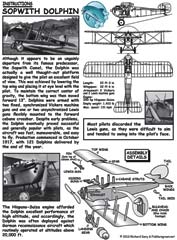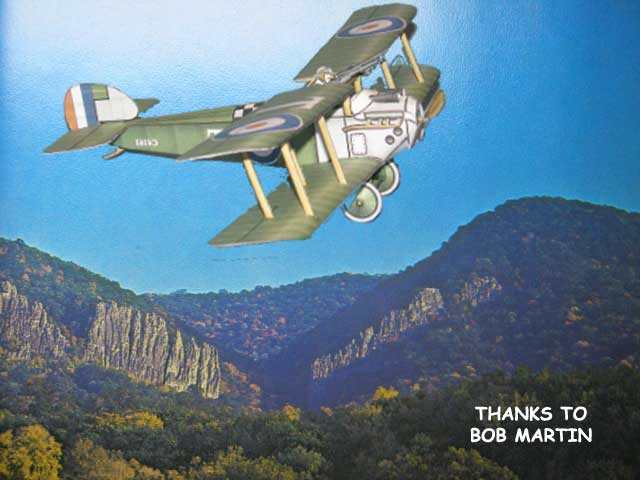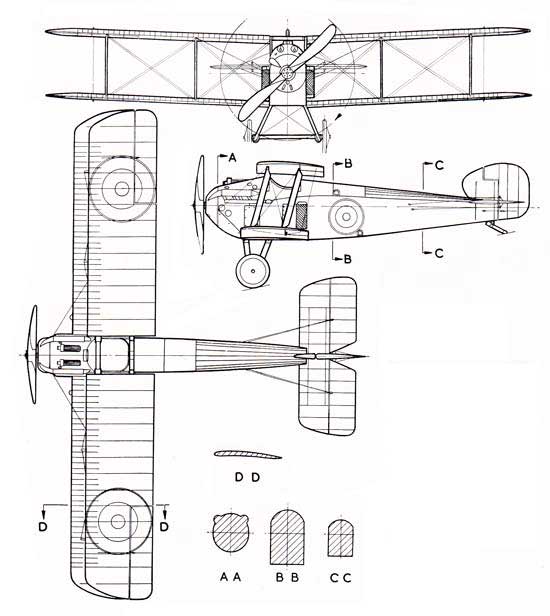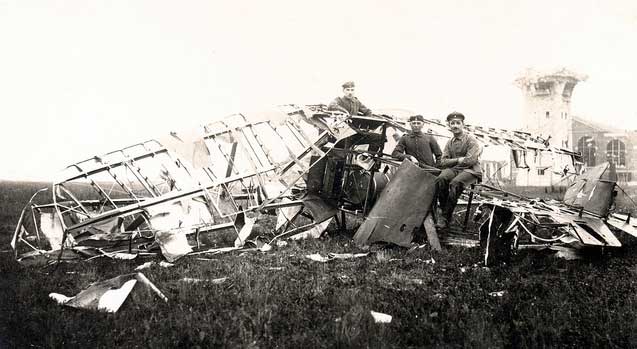

Sopwith-Dolphin - $$7.50
Last WWI Scout design offered by Sopwith. The Sopwith 5F.1 Dolphin was a British Fighter used by the Royal Flying Corps and its successor, the Royal Air Force, during the First World War. The Dolphin entered service on the Western Front in early 1918 and proved to be a formidable fighter.
5F.1 Sopwith Dolphin WWI Scout

SOPWITH DOLPHIN 5F.1
In May 1911 the Sopwith Aviation Company produced a new single-seater fighter biplane, the 5F.l Dolphin, powered by the 200 h.p. geared Hispano-Suiza engine. The wings were rather surprisingly given 'backward stagger' with the object of affording the best possible upward view. The top wing was fixed just above the cockpit so that the pilot sat with his head through the open center section, a frame of steel tubing.
 C4131 was flown by Captain W. M. Fry when he scored his 11th victory on 11 May 1918. Also flown by Lt. V. G. Snyder, C4131 featured a black and white checkerboard on the turtle deck. |
A bulky car-type radiator was fitted; the rest of the airplane was of normal wood-framed and wire-braced construction covered with fabric except for the plywood top decking and cockpit sides. The original rudder and fin resembled those of the Sopwith Camel.
The view forwards and downwards was soon found to be unsatisfactory, so the frontal radiator was replaced by two side radiators with adjustable flaps, the engine was given a rounded cowling and cut-outs were made in both wing-roots. An enlarged horn-balanced rudder was fitted.
The production model appeared with much lower sides to the cockpit, no cut-outs, and an enlarged fin which gave the vertical tail surfaces a more rounded shape. To the standard armament of two Vickers guns were added a pair of Lewis guns, mounted on the front of the center section at an angle of 45 degrees. These could be swung upwards to fire almost vertically. On operations, however, the Lewis guns were usually removed. No. 87 squadron transferred theirs to the lower wings, to fire outside the airscrew arc.
 Initially the Dolphin was not received by the R.F.C. with much enthusiasm, one of the more obvious reasons being the likelihood of a broken neck if the machine turned over when landing! As a safety measure some units fitted crash pylons over the center sections, while modifications were made to the center-section bracing wires to enable the pilot to escape after a crash. The night-flying version was provided with steel half-hoops above the top wing over each inner bay of struts.
Initially the Dolphin was not received by the R.F.C. with much enthusiasm, one of the more obvious reasons being the likelihood of a broken neck if the machine turned over when landing! As a safety measure some units fitted crash pylons over the center sections, while modifications were made to the center-section bracing wires to enable the pilot to escape after a crash. The night-flying version was provided with steel half-hoops above the top wing over each inner bay of struts.
In January 1918 No. 19 Squadron on the Western Front replaced their SPADs with Dolphins, and in March a new squadron, No. '79, arrived in France equipped with the Dolphin. Both units were active during the fierce fighting that followed the start of the German offensive of March 21st. The other SPAD squadron, No. 23, received Dolphins in April, and the fourth squadron to use the machine operationally, No. 87, reached the front in the same month. All four Dolphin squadrons played a useful if not outstanding part in the summer and autumn battles, mainly on escort and ground-attack duty. The type proved to be fast, maneuverable and easy to fly; the geared Hispano-Suiza engine, however, gave a good deal of trouble.
A few Dolphins were used by No. 141 (Home Defense) Squadron, but were considered unsuitable, due to the lengthy warming-up period required by their liquid-cooled engines.
 |
 |
 |
 |
 A larger sized plan is included with your Sopwith Dolphin purchase |
|
 |
|
The Sopwith Dolphin, a British fighter aircraft from World War I, was introduced in 1917 by the Sopwith Aviation Company and served with the Royal Flying Corps and later the Royal Air Force until the war's end in 1918. Designed for high-altitude combat, it featured a unique wing configuration with the top wing positioned forward for better pilot visibility and four synchronized machine guns, making it a formidable dogfighter. Despite initial engine reliability issues with the Hispano-Suiza V8, the Dolphin proved fast and maneuverable, excelling in engagements above 15,000 feet. By February 1918, squadrons like No. 19 and No. 87 were equipped with Dolphins, contributing to Allied air superiority. Pilots praised its stability and firepower, though its production was limited to around 2,000 units due to wartime constraints. Today, replicas and preserved examples, like the one at the RAF Museum, highlight its innovative design in aviation history. Building this paper model captures the Dolphin's legacy as a "better than the Camel" evolution in early aerial warfare. |
 |
Wreckage of a Sopwith Dolphin near the steelworks at Wingles (France) 5 July 1918 |


